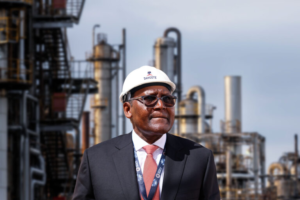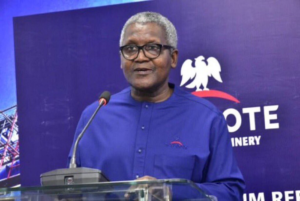
In a recent discussion, Alex Ogedengbe, a former Group Executive Director of the Nigerian National Petroleum Company Ltd. (NNPC), advised Nigerians to temper their expectations regarding the anticipated functioning of the Port Harcourt refinery.
Emphasizing that there are indications the refinery won’t be operational this month, the former managing director of both the Kaduna and Port Harcourt refineries asserted that even if it does commence operations, it would produce no more than 25% of petrol per barrel of crude oil.
Despite skepticism among Nigerians, the NNPC and the Ministry of Petroleum have asserted that the 60,000 bpd segment of the 210,000 bpd refinery is set to commence operations in December.
A few days ago, the NNPC released an update on the Port Harcourt refinery, where its current Managing Director, Ibrahim Onoja, had maintained that it would be ready this month.
However, Ogedengbe, who spoke on Channels Television, insisted that even from the information from the video update, it was not possible that the plant would work this year.
He stated that the old refinery NNPC was focusing on fixing, had not worked for over 30 years.
“If what I heard from that short, nine-minute release by the MD of the refinery is anything to go by, at best they will have some kind of mechanical completion by the end of December, because he said they are 75 per cent done overall, but 98 per cent done on procurement.
“But by end of December, at best, they will have mechanical completion, then they will do the testing of each equipment and systems.
“You test one equipment, you see how it fits with another one. Then you put everything together as a system. The system tests may take anything from two weeks to one month before you can start, in my opinion, based on what he said.
“I don’t think it can be done more than within two or three months. Now, what you will get there again, is something like the old refinery of 60 years ago with just new equipment. The capacity is still 60,000 barrels per day.
“The old refinery that is being repaired now, cannot produce more than 25 per cent maximum of crude oil. In other words, one barrel of crude will produce a maximum of 25 per cent of petrol. Whereas, the newer Port Harcourt refinery which is next door to the old one they are repairing can produce up to 48 per cent or 50 per cent on crude oil.
“So, overall, I don’t expect any appreciable contribution. That is even if all the systems work. I don’t have confidence in that right now from what I’ve seen,” he stated.
He said in October, during an engineers’ fellows’ meeting made up of at least three ex-managing directors of NNPC refineries, they were not allowed to visit as the scheduled event was cancelled in the last minute.
Ogedengbe, stated in the early 90s when he ran the facilities, there was no need to import products as all the refineries which were working at the time have now shut down.
As an engineer, he argued that if he was told that there was a proper plan to get the refineries from zero production to 100 per cent 10 years ago, he would believe, but noted that with the depth of damage that had happened, he doubted it.
Ogedengbe, wondered why the national oil company did not pick the newer 150,000 barrels per day facility which was built 30 years later and is beside the 60,000 bpd built almost 60 years ago.
“The old refinery, the one that was built in 1965, that’s about 58 years ago, has not operated since 1990 when the new refinery came on. So, it’s been shut down,” he disclosed.
Ogedengbe recalled that he was the project manager when the new refinery in Port Harcourt was built between 1985 to 1990, stressing that the new one is a more complex and modern facility and should have been fixed first.
“If you put one barrel of crude oil into the new one, 48 to 50 per cent of it will be petrol. The old refinery, if you put one barrel of crude oil into it, you only get maximum 23 to 24 per cent of petrol, which shows the complexity.
“The old refinery has just one conversion unit that can produce petrol. The new refinery has four different conversion units. That is the issue. Why is this old refinery being rehabilitated instead of the new one?
“The old refinery was built in 1965 with a different old technology. Now what is being done there? “ he asked, stressing that rather than rehabilitation as Nigerians have been told, it was actually being reconstructed.
While insisting that the refinery cannot work in December, he stated that testing each functional part of the refinery alone, if any part of it works, will take at least three months to achieve.
“There is no way we can justify the situation we have today. The refineries were built according to international standards. They were all tested for completion and they performed at the time they were completed.
“They ran according to the design for many years. However, being a government-owned facility, not a private one, they were not run commercially.
“What does that mean? Monies did not come in time for maintenance. Not enough money actually was given for maintenance and it was not a profitable project. So it was just declining slowly because of lack of maintenance until it crashed. All of them crashed by 2018,” he stressed.
He stated that although during his time money was usually budgeted for maintenance, but such monies were never fully released by the NNPC headquarters.
To augment this, he said the Kaduna and Port Harcourt refineries at the time he was the managing director, went out of its way to begin the production of tins and drums to survive.
“Every month, we will receive between 50 and 60 per cent of our budget. We are supposed to pick up the rest somehow. You have to be imaginative.
“ When I was in Kaduna refinery for instance, it was the only refinery that had a tin and drum manufacturing plant, which is not typically a refinery thing, but we had that plan because we were producing kerosene and we were selling in tins.
“So I was selling ordinary tins and drums to people who were buying them for water and other uses to augment the budget for the refinery operations,” he said.
He added that he was surprised that a 58-year-old refinery will be picked over the one that was built 30 years later, stressing that the guess is that the NNPC wanted to do a quick fix “politically”.
He noted that it was the reason the original contractor of the newer Port Harcourt refinery refused to participate in the current rehabilitation process. “They did not think that was the right way to go,” he maintained.
On why monies were not fully released for maintenance during his days as head of the refineries, Ogedengbe stated that the question should be directed at the corporate headquarters of the NNPC at the time which controlled the budget.
He stated that as the refineries’ managing director, he only handed the products to the products marketing arm of the NNPC, which would sell them while the revenues were sent to the headquarters.
“In 1990, we generated products at about an average of 95 per cent throughput in refineries in Port Harcourt combined, old or new”, he stated, adding that at the time there was no fuel scarcity, but that Nigeria even had some for export.
“They awarded a contract of $1.5 billion three years ago or two and a half years ago. So, the first person when you are in doubt, is to ask the contractor to speak. Let us see the report of the contractors. We haven’t seen that,” he lamented.






Be First to Comment